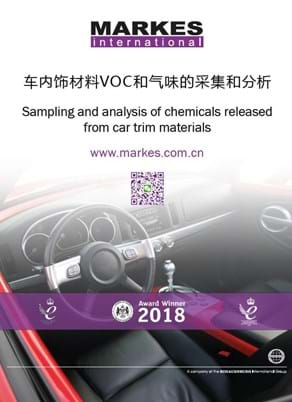
New car smell: Update to vehicle interior air quality regulations
19 August, 2019
‘Emissions and Odor of Plastics’ workshop
July’s ‘Emissions and Odor of Plastics’ workshop, hosted by development and engineering company imat-uve in Shanghai, China, focused on the continuing issue of how to reduce chemical emissions from materials to vehicle interiors.
The discussions centered on how to sample, analyse and reduce levels of the compounds known to be of toxicological concern, as well as those producing odours that consumers find unpleasant.
Addition of more VOCs to GB/T 27630
In his presentation to the 100 attendees, Dr Yanmeng Wang from the China Automotive Technology & Research Center (CARTAC) confirmed that in addition to the 8 regulated compounds, 25 additional ‘most abundant’ VOCs will be added to China’s automotive regulation GB/T 27630, ahead of the 2020 implementation.
The addition of these compounds means that previous hopes for using real-time MS techniques for sampling target compounds have been dashed, because that method is limited to quantitation of known targets. In addition, the concern from material manufacturers is that the ‘most abundant’ compounds do not necessarily mean the most odorous, so despite this change, more odour-producing targets could well be added at a later date.
Current methods used to test for VOCs in vehicle interior air
Dr Michael Holzwarth, who is the Senior Manager (VIAQ, VOC, Odor) at imat-uve, followed Dr Wang with an overview of standard test methods, procedures and principles, and the differences between the various analyses. His talk highlighted the need to ensure that sampling parameters are understood, and how results can vary if these are not considered. He also provided a demonstration of imat-uve’s very useful ‘high precision micropunch’ for the repeatable preparation of VDA 278 samples.

Combining analytical instruments and the human nose
Dr Nathalie Nibbe from odour equipment consultants Olfasense gave a thought-provoking presentation about the identification of malodours using ‘GC-sniffing.’ Dr Nibbe said that the use of gas chromatography, which she said was “the leading technique for separation and analysis of VOCs”, alongside olfactory testing is a great way to identify compounds contributing to an off-odour. However, she also highlighted the need to ensure the ‘sniffers’ were correctly trained, especially in the vocabulary of odors, to ensure any descriptive words were uniformly used.
Other highlights came from Dr Nils Krümmel, Lab and R&D Director of Shanghai Mankiewicz Innovative Coatings, who discussed how improved VIAQ could be obtained by using innovative coating technologies that rely on improved substrate quality and consequently use less solvent. Meanwhile, Dr Shuaike Shi from Evonik Specialty Chemicals focused on non/low-emission solutions for polyurethane materials, stressing the importance of novel amine catalysts with zero emissions.
The value of thermal desorption for emissions testing
As highlighted in this workshop, TD remains the leading technique for monitoring emissions released from vehicle interior air. At Markes we’ve got a wealth of experience of this topic, so if you need any clarification of ongoing developments in regulations or instrumentation, please don’t hesitate to let us know.
For a summary of the regulatory framework in VIAQ, take a look at Application Note 131.







